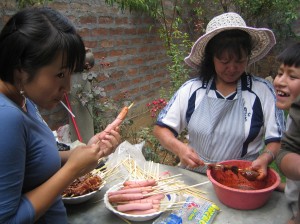My professor from Canada came to visit for a whirlwind week and packed in…
- A 2-day conference on infant stimulation that we’ve been planning for months,
- A full day of hardcore bulk shopping in the Sunday fair that spans more than 30 city blocks of the main street through Huancayo (mostly jewellery for her and millions of other trinkets that her son can sell back home),
- And the rest of the week was spent conducting full days of research with babies and toddlers in San Pedro de Saño (a little town just outside of the big city).
Part of her assignment here was to conduct mid-internship Coady interviews individually with Maria and me. The question that had me thinking went something like this: “What skills have you learned from your internship that will benefit you in your future work?” Skills, skills, skills. The first skills that came to mind when I thought of what I’ve learned here in Huancayo had nothing to do with my internship. I thought of how I could now fill the kettle without it spilling in pitch darkness, notice the slight difference in sound when the water had started boiling, and how my internal clock knew when the 10 minutes of boiling time was up (to be sure the water was purified) because I do this every morning to make my coca tea. I thought of how I skilled I was at doing laundry by hand (well, sorta). I thought of how I learned to keep an apartment clean (because Maria made me, just kidding – sorta; she was the positive influence, that’s what I meant). And I’d like to say that I can now cook, but just the other day, I suggested we add mango pieces to our pasta dish and Maria said that it would never work. =P It is a skill that will take a much longer time for me to learn, I’m afraid.
In any case, I had to think twice to respond to the actual question. What skills had I learned? Not just any skill, but something that will benefit me in my future field? I’ve learned a heck of a lot about international development – which I didn’t even know existed prior to arriving in Nova Scotia for training – but to be honest, I’m not so sure I’ll be involved in this field in the future. It had to be something more abstract.
Then, it came to me. “Flexibility and patience,” I answered. It is a skill to be able to get along with people from other cultures, whether it’s the Dutch (there is the couple who started the NGO and the other two volunteers from the Netherlands) or the wide variety of Peruvians here (of different ages, ethnic backgrounds, and lifestyles). It’s about learning to accept differences, personal boundaries, and idiosyncrasies, taking everything in with an open attitude instead of succumbing to the natural temptation to judge. For me personally, it was also what I needed in order to learn the language – flexibility in the choice of words (because not every phrase can be translated literally) and patience with myself as I made a million mistakes.
As I thought of that, I realized that another skill I had developed (that I had wanted to develop) was the ability to laugh at myself. Recently, we (the interns in all the different corners of the world) were sent the letters we had written to ourselves at the beginning of everything, in July when we were still in Nova Scotia. I had written, “I hope you learn to laugh at yourself.” I think I had to lose the fear of embarrassing myself especially when you’re learning to speak a foreign language because it’s bound to happen that you’ll be telling someone, “Can I feel myself here?” (sentirme) instead of “Can I sit here?” (sentarme).
It seems to me that a fundamental issue many have once they start working full-time is that they stress out, take things personally, take things too seriously, and start thinking only about themselves and their dissatisfaction. This is when these skills will come into play in my future work: flexibility (letting things be as they are instead of always fitting things into a certain schedule or plan), patience (with myself as I know that I will inevitably make mistakes and I will be the most conscious of this if I ever find myself in a more senior position, with higher expectations of myself and more susceptible to being intolerant of my blunders), and the ability to laugh at myself (to keep relaxed in this way, living life light-heartedly so that I have a balanced relationship with myself, my co-workers, my family, and my friends).



